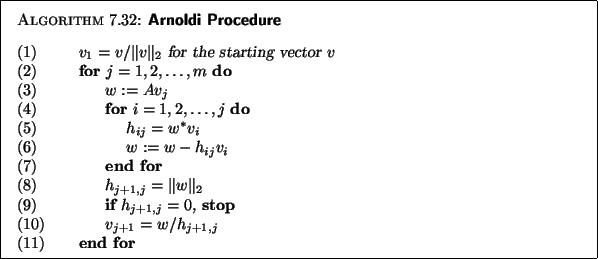
The above procedure
will stop if the vector ![]() computed in line (8) vanishes.
The vectors
computed in line (8) vanishes.
The vectors
![]() form an orthonormal system
by construction and are called Arnoldi vectors.
An easy induction argument shows that this system is a basis of
the Krylov subspace
form an orthonormal system
by construction and are called Arnoldi vectors.
An easy induction argument shows that this system is a basis of
the Krylov subspace ![]() .
.
Next we consider a fundamental relation between quantities
generated by the algorithm.
The following equality is readily derived:
As was noted earlier the algorithm breaks down when the norm of ![]() computed on line (8) vanishes at a certain step
computed on line (8) vanishes at a certain step ![]() . As it turns out,
this happens if and only if
the starting vector
. As it turns out,
this happens if and only if
the starting vector ![]() is a combination of
is a combination of ![]() eigenvectors (i.e.,
the minimal polynomial of
eigenvectors (i.e.,
the minimal polynomial of ![]() is of degree
is of degree ![]() ).
In addition, the subspace
).
In addition, the subspace ![]() is then invariant and
the approximate eigenvalues and eigenvectors are exact
[387].
is then invariant and
the approximate eigenvalues and eigenvectors are exact
[387].
The approximate eigenvalues
![]() provided by the
projection process onto
provided by the
projection process onto ![]() are the eigenvalues of the Hessenberg
matrix
are the eigenvalues of the Hessenberg
matrix ![]() . These are known as Ritz values.
A Ritz approximate eigenvector associated with a Ritz value
. These are known as Ritz values.
A Ritz approximate eigenvector associated with a Ritz value
![]() is defined by
is defined by
![]() , where
, where ![]() is an eigenvector associated with the eigenvalue
is an eigenvector associated with the eigenvalue
![]() . A number of the Ritz eigenvalues,
typically a small
fraction of
. A number of the Ritz eigenvalues,
typically a small
fraction of ![]() , will usually constitute good approximations
for corresponding eigenvalues
, will usually constitute good approximations
for corresponding eigenvalues ![]() of
of ![]() , and the quality of the
approximation will usually improve as
, and the quality of the
approximation will usually improve as ![]() increases.
increases.
The original algorithm consists of increasing ![]() until all desired
eigenvalues of
until all desired
eigenvalues of ![]() are found. For large matrices, this becomes
costly both in terms of computation and storage.
In terms of storage, we need to keep
are found. For large matrices, this becomes
costly both in terms of computation and storage.
In terms of storage, we need to keep ![]() vectors of
length
vectors of
length ![]() plus an
plus an ![]() Hessenberg matrix, a total of approximately
Hessenberg matrix, a total of approximately
![]() . For the arithmetic costs,
we need to multiply
. For the arithmetic costs,
we need to multiply ![]() by
by ![]() , at the cost of
, at the cost of ![]() , where
, where ![]() is number of nonzero elements in
is number of nonzero elements in ![]() ,
and then orthogonalize the result against
,
and then orthogonalize the result against ![]() vectors at the cost of
vectors at the cost of ![]() which increases with the step
number
which increases with the step
number ![]() . Thus an
. Thus an ![]() -dimensional Arnoldi procedure costs
-dimensional Arnoldi procedure costs
![]() in storage and
in storage and
![]() in arithmetic operations.
in arithmetic operations.
Obtaining the residual norm, for a Ritz pair,
as the algorithm progresses is fairly inexpensive.
Let ![]() be an eigenvector of
be an eigenvector of ![]() associated with the
eigenvalue
associated with the
eigenvalue
![]() , and let
, and let ![]() be the Ritz approximate
eigenvector
be the Ritz approximate
eigenvector
![]() .
We have the relation
.
We have the relation